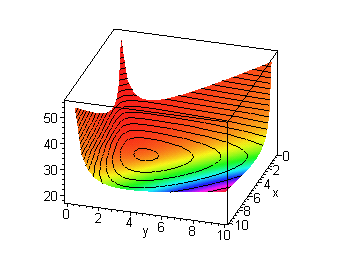| xn+1 = (a + xn )/ xn-1 |
where the parameter a > 0, x n-1 > 0, x0 > 0.
The invariant of this equation is:
| I(xn , xn-1 ) = (1+1/xn )(1+1/xn-1 )(a+xn +xn-1 ) |
The Lyness equation has the equilibrium value:
| p=(1±(1+ 4a)1/2)/2 |
THEOREM (Discrete version of the Dirichlet's theorem). Consider the difference equation
|
By using the above
theorem, the Liapunov function, V(x,y) for this equation is found to be
given by:
| V(x,
y)= I(x, y)-I(p,
p)=
I(x,
y) - (p+1)3
/p
V(x, y)=(1+1/x)(1+1/y)(a+x+y)-(p+1)3 /p |
3-d Plot of the Invariant of Lyness' Equation

View an animated version of the above graph.
For more information about Lyness' Equation:
- Geometric Unfolding of a Difference Equation a lecture by:
"Technical skill is mastery of complexity while creativity is mastery of simplicity."
Catastrophe Theory, 1977.
Click here to go to Home Page for Difference
Equations at URI